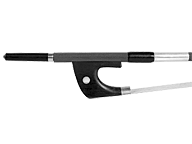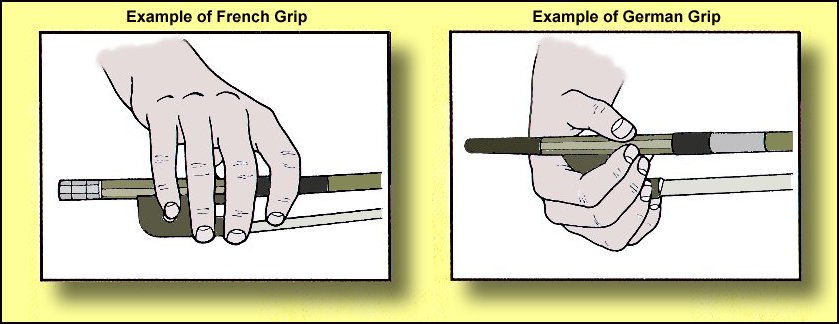French or German Bow - Which should I choose?
Unlike the other stringed instruments, with bass you have a choice of bow styles. If you're new to the bow, how are you supposed to know which one to choose? Here's a quick overview to help you decide.
 French FrenchThe French bow has a smaller frog (the part of the bow you hold) and looks more like the bows you'd use to play cello, viola or violin. It is also held in a similar fashion as with those instruments, with an "overhand" grip. |
 German GermanThe German bow (aka "Butler") has a taller frog and is held in an "underhand" grip. Generally speaking, the rest of the bow is virtually identical, using a similar stick, and is haired in the same way. |

So what's that mean to you? Here are some additional thoughts:
- There isn't one type of bow that is necessarily "better." It's sort of like asking, "what's better, vanilla or chocolate?"
- Often, the primary reason that a player would choose one over the other is because "that's what my teacher played and that's what he/she taught me."
- That said, many players feel that a French bow is better for "finesse" and a German bow is better for "power."
- Accordingly, many orchestral players actually become competent with both bow styles and own bows of each style to suit specific performance needs.
- ...And there are plenty of bassists who play French with power and/or German with finesse.
- French bows used to have a substantial edge in the USA, but German bows have made a resurgence. We still sell more French than German, but not by nearly as big a margin.
- Learning materials for French are probably a little easier to come by due to this popularity (and their similarity to the bows of the rest of the string family). So if you're not already married to one or the other - and are learning on your own - opting for French may ease the transition to arco - especially if you have experience with other instruments in the string family.
- We always recommend studying with a reputable instructor, especially when starting the instrument or a new technique (like arco) - so ask your teacher which is best for you!
- There are multiple variations of the grips as illustrated in the examples below, so don't accept what's shown as "gospel"; your teacher's technique or your learning materials may differ.
An Important Note About Caring for/Handling Bows:
Especially when under tension, a simple rap against a hard surface (like the post of a music stand) can easily break a bow. Bumping into a bow that is perched on the lip of a music stand is also a common "maker of unhappy bassists" -- the bow hits the floor, and suddenly the stick is in two pieces. I really hate taking those phone calls -- it makes me sad, as such a tragedy can be easily avoided, but also, parents of younger players who deny they did anything (would you expect them to fess up?) often incorrectly blame the bow.
Put simply, a bow that "snaps" from a seemingly innocuous rap against a chair leg is not a sign of a "defective" bow, any more than shattering a glass vase by grazing a marble countertop would be considered the fault of the vase.
We STRONGLY recommend that you (and/or your bass-playing children) exercise prudent, responsible handling of ANY wooden bow, whether bought from us or not. A wooden bow is a fragile musical instrument in and of itself, and should be treated with the same care afforded the bass.
To limit accidents, there are bow "holders" available, which can help keep them safe from harm; we sell bow quivers (a leather bow "holster" that ties to the tailpiece) as well as inexpensive hooks that clip onto the music stand, providing a safer means for putting the bow down for pizz sections. You can find them in the Bow Accessories section.
